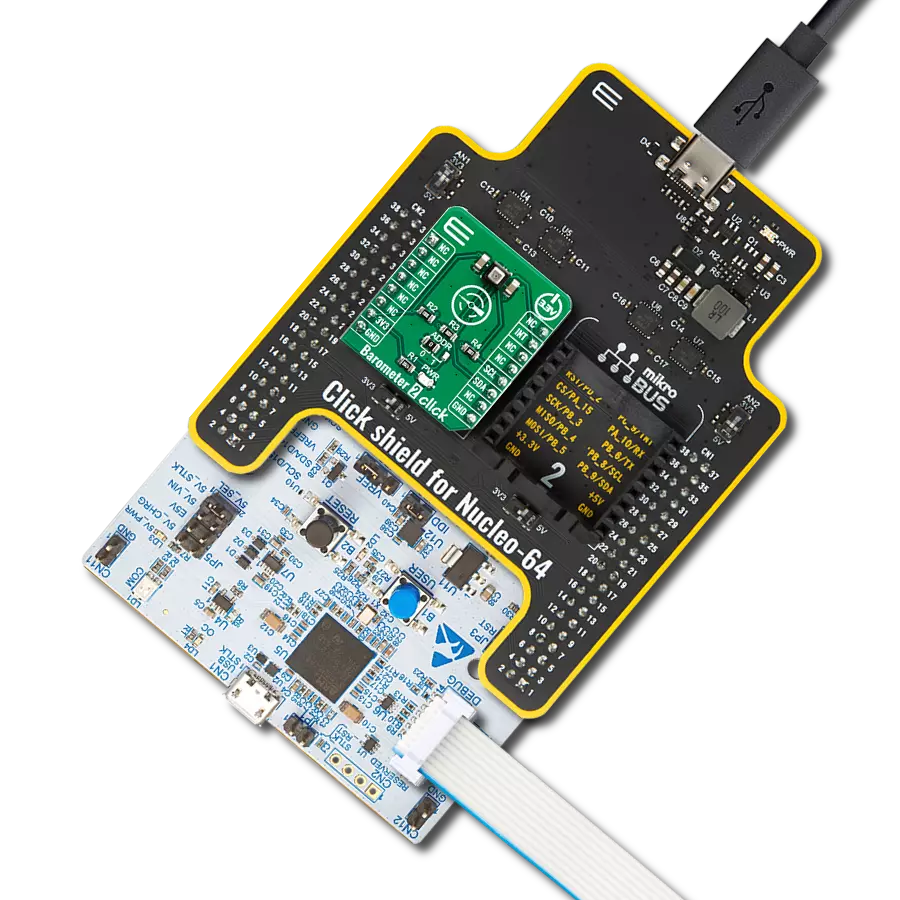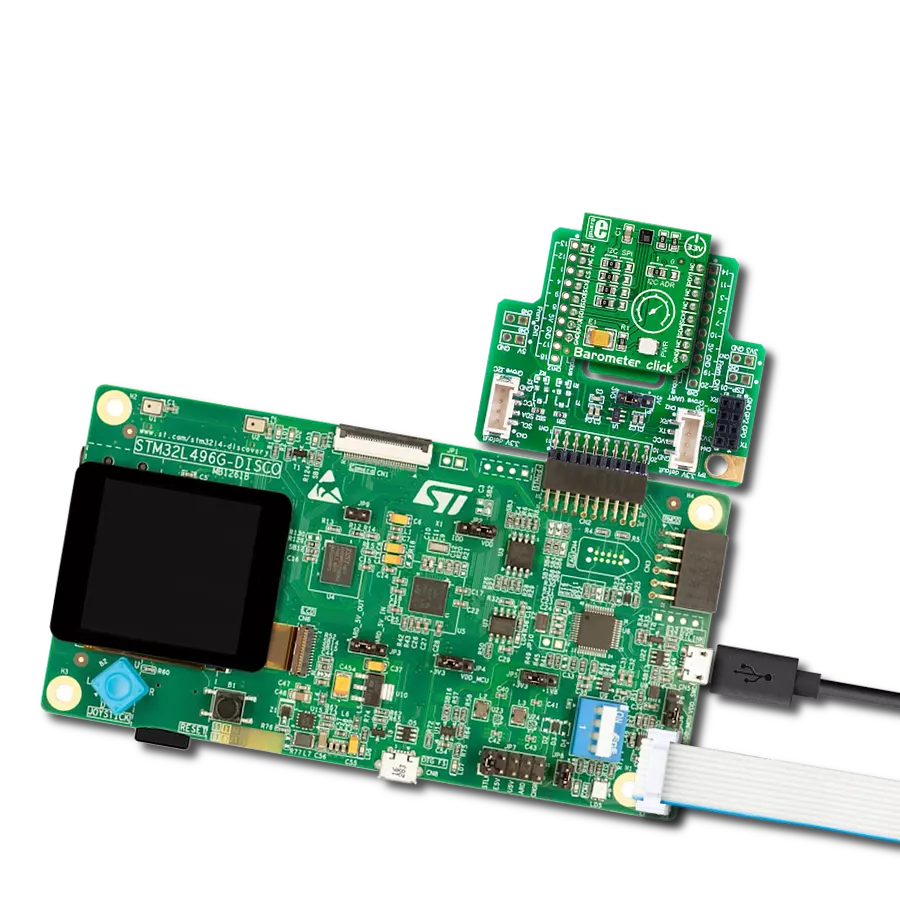Explore the principles and technology behind differential pressure sensors, highlighting their critical role in modern measurement systems
A
A
Hardware Overview
How does it work?
Diff Press 2 Click is based on the SDP31-500PA, a highly versatile differential pressure sensor designed for high-volume applications from Sensirion. It builds on the next-generation CMOSens® sensor chip at the heart of Sensirion’s new differential pressure and flows sensing platform. It features fast measurement speed, excellent accuracy, and long-term stability, has no zero-point drift, and offers an ultra-low power consumption, making the SDP31-500PA the perfect choice for applications where accurate and reliable pressure monitoring is essential. The SDP31-500PA is very flexible regarding
measurement speed. This flexibility allows for optimizing the sensor’s performance for a specific application and for adapting the sensor to different use cases. For example, the sensor detects the smallest and quickest changes in one use case, whereas, in another mode, the sensor can measure in larger intervals while consuming only a little energy. Diff Press 2 Click communicates with MCU using the standard I2C 2-Wire interface to read data and configure settings, supporting Fast Mode up to 400kHz. Besides, the SDP31-500PA allows choosing the least significant bit (LSB) of its I2C slave address
using the SMD jumper labeled ADDR SEL. It also possesses an additional interrupt signal, routed on the INT pin of the mikroBUS™ socket labeled as INT, indicating when a specific interrupt event occurs, such as whether new measurement results are available. This Click board™ can operate with either 3.3V or 5V logic voltage levels selected via the VCC SEL jumper. This way, both 3.3V and 5V capable MCUs can use the communication lines properly. Also, this Click board™ comes equipped with a library containing easy-to-use functions and an example code that can be used as a reference for further development.
Features overview
Development board
PIC18F57Q43 Curiosity Nano evaluation kit is a cutting-edge hardware platform designed to evaluate microcontrollers within the PIC18-Q43 family. Central to its design is the inclusion of the powerful PIC18F57Q43 microcontroller (MCU), offering advanced functionalities and robust performance. Key features of this evaluation kit include a yellow user LED and a responsive
mechanical user switch, providing seamless interaction and testing. The provision for a 32.768kHz crystal footprint ensures precision timing capabilities. With an onboard debugger boasting a green power and status LED, programming and debugging become intuitive and efficient. Further enhancing its utility is the Virtual serial port (CDC) and a debug GPIO channel (DGI
GPIO), offering extensive connectivity options. Powered via USB, this kit boasts an adjustable target voltage feature facilitated by the MIC5353 LDO regulator, ensuring stable operation with an output voltage ranging from 1.8V to 5.1V, with a maximum output current of 500mA, subject to ambient temperature and voltage constraints.
Microcontroller Overview
MCU Card / MCU

Architecture
PIC
MCU Memory (KB)
128
Silicon Vendor
Microchip
Pin count
48
RAM (Bytes)
8196
You complete me!
Accessories
Curiosity Nano Base for Click boards is a versatile hardware extension platform created to streamline the integration between Curiosity Nano kits and extension boards, tailored explicitly for the mikroBUS™-standardized Click boards and Xplained Pro extension boards. This innovative base board (shield) offers seamless connectivity and expansion possibilities, simplifying experimentation and development. Key features include USB power compatibility from the Curiosity Nano kit, alongside an alternative external power input option for enhanced flexibility. The onboard Li-Ion/LiPo charger and management circuit ensure smooth operation for battery-powered applications, simplifying usage and management. Moreover, the base incorporates a fixed 3.3V PSU dedicated to target and mikroBUS™ power rails, alongside a fixed 5.0V boost converter catering to 5V power rails of mikroBUS™ sockets, providing stable power delivery for various connected devices.
Used MCU Pins
mikroBUS™ mapper
Take a closer look
Click board™ Schematic

Step by step
Project assembly
Software Support
Library Description
This library contains API for Diff Press 2 Click driver.
Key functions:
diffpress2_get_id- Reads device ID'sdiffpress2_reset- Reset devicediffpress2_trigger_measurement- Pressure and temperature reading
Open Source
Code example
The complete application code and a ready-to-use project are available through the NECTO Studio Package Manager for direct installation in the NECTO Studio. The application code can also be found on the MIKROE GitHub account.
/*!
* @file main.c
* @brief DiffPress2 Click example
*
* # Description
* This example application showcases ability for device
* to read and calculate mass flow or diff press pressure
* in Pascals and temperature in degrees Celsius.
*
* The demo application is composed of two sections :
*
* ## Application Init
* Initialization of module communication(I2C, UART) and
* additional interrupt pin. Resets device and reads
* serial and product ID's and logs them.
*
* ## Application Task
* Read and calculate differential in Pascal and temperature
* in degrees Celsius every 300ms.
*
* @author Luka Filipovic
*
*/
#include "board.h"
#include "log.h"
#include "diffpress2.h"
static diffpress2_t diffpress2;
static log_t logger;
void application_init ( void )
{
log_cfg_t log_cfg; /**< Logger config object. */
diffpress2_cfg_t diffpress2_cfg; /**< Click config object. */
/**
* Logger initialization.
* Default baud rate: 115200
* Default log level: LOG_LEVEL_DEBUG
* @note If USB_UART_RX and USB_UART_TX
* are defined as HAL_PIN_NC, you will
* need to define them manually for log to work.
* See @b LOG_MAP_USB_UART macro definition for detailed explanation.
*/
LOG_MAP_USB_UART( log_cfg );
log_init( &logger, &log_cfg );
log_info( &logger, " Application Init " );
// Click initialization.
diffpress2_cfg_setup( &diffpress2_cfg );
DIFFPRESS2_MAP_MIKROBUS( diffpress2_cfg, MIKROBUS_1 );
err_t init_flag = diffpress2_init( &diffpress2, &diffpress2_cfg );
if ( I2C_MASTER_ERROR == init_flag )
{
log_error( &logger, " Application Init Error. " );
log_info( &logger, " Please, run program again... " );
for ( ; ; );
}
if ( diffpress2_default_cfg ( &diffpress2 ) )
{
log_error( &logger, " Default configuration." );
for ( ; ; );
}
log_printf( &logger, " > Product ID: 0x%.8LX\r\n", diffpress2.product_id );
log_printf( &logger, " > Serial ID: 0x%.8LX%.8LX\r\n",
diffpress2.serial_id[ 0 ], diffpress2.serial_id[ 1 ] );
log_info( &logger, " Application Task " );
}
void application_task ( void )
{
float pressure;
float temperature;
if ( diffpress2_trigger_measurement( &diffpress2, DIFFPRESS2_CMD_TRIGGER_MEAS_DIFF_PRESS,
&pressure, &temperature ) )
{
log_error( &logger, " Read data." );
}
else
{
log_printf( &logger, " > Pressure[Pa]: %.2f\r\n", pressure );
log_printf( &logger, " > Temperature[degC]: %.2f\r\n", temperature );
log_printf( &logger, "*************************************\r\n" );
}
Delay_ms ( 300 );
}
int main ( void )
{
/* Do not remove this line or clock might not be set correctly. */
#ifdef PREINIT_SUPPORTED
preinit();
#endif
application_init( );
for ( ; ; )
{
application_task( );
}
return 0;
}
// ------------------------------------------------------------------------ END
Additional Support
Resources
Category:Pressure




































